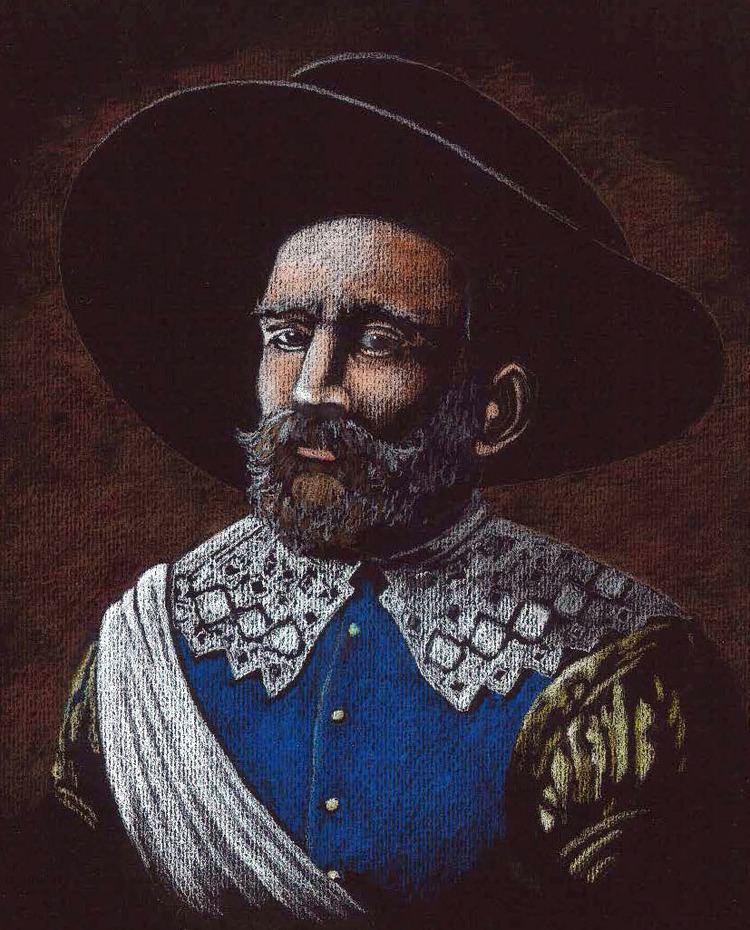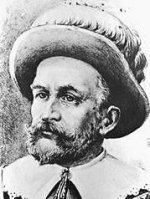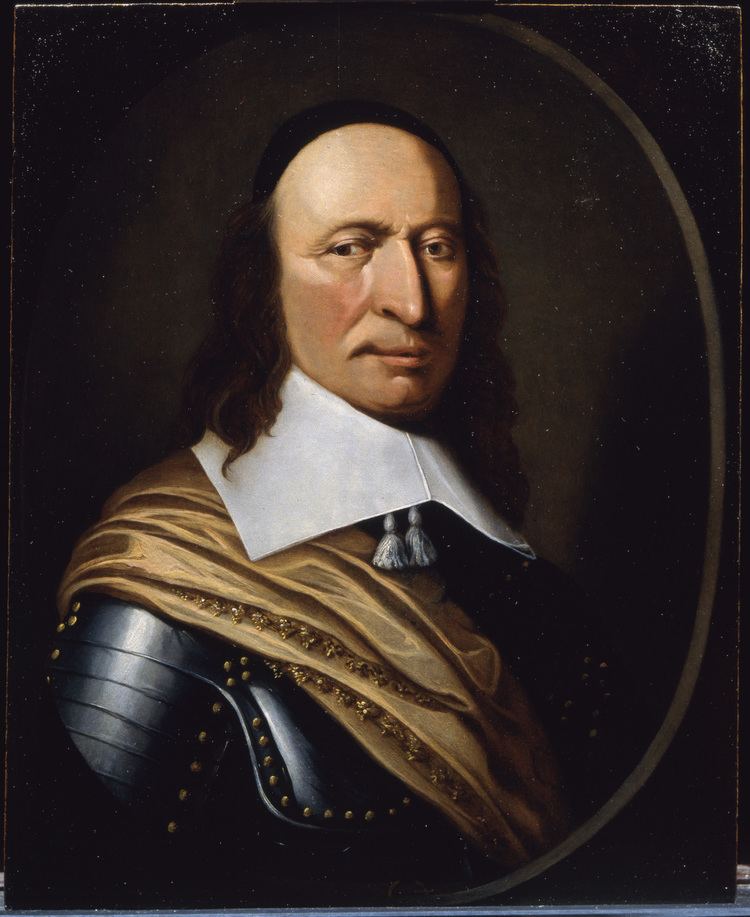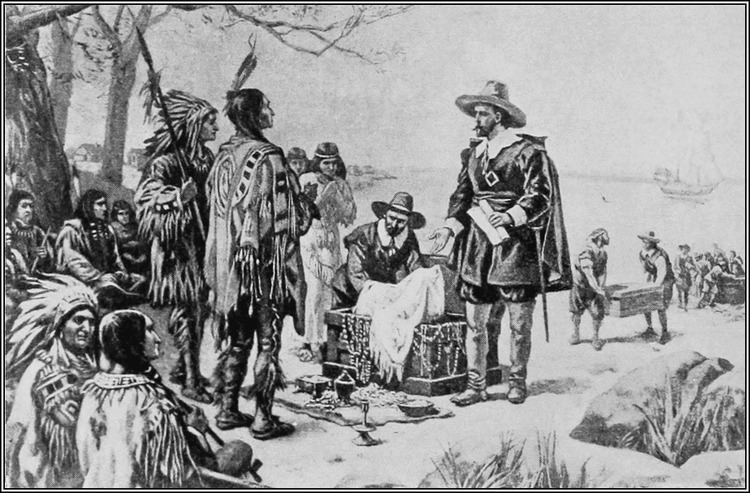Name Peter Minuit | ||
 | ||
Died August 5, 1638, Saint Kitts, Saint Kitts and Nevis Similar People Peter Stuyvesant, Henry Hudson, Jacques Marquette | ||
Peter Minuit
Carrie Hogan on Peter Minuit in the New Sweden Colony
Peter Minuit, Pieter Minuit, Pierre Minuit or Peter Minnewit (between 1580 and 1585 – August 5, 1638) was a Walloon from Wesel, in present-day North Rhine-Westphalia, Germany, then part of the Duchy of Cleves. His surname means "midnight" in French. He was Director of the Dutch colony of New Netherland from 1626 until 1631, and founded the Swedish colony of New Sweden in 1638.
Contents
- Peter Minuit
- Carrie Hogan on Peter Minuit in the New Sweden Colony
- Early life
- Career as Director of New Netherland
- Establishing the New Sweden colony
- Places named after Minuit
- In popular culture
- References

Minuit is generally credited with orchestrating the purchase of Manhattan Island for the Dutch from the Lenape Native Americans. Manhattan later became the site of the Dutch city of New Amsterdam, modern-day New York City. A common myth states that Minuit purchased Manhattan for $24 worth of trinkets; However, a letter written by Dutch merchant Peter Schaghen to directors of the Dutch East India Company stated that Manhattan was purchased "for the value of 60 guilders," an amount worth around $1,050 in 2015 dollars. Minuit also founded the Delaware colony in the early 1600s.

Early life

Peter Minuit was born sometime between 1580 and 1585, into a Protestant family that had moved from the city of Tournai in the Southern Netherlands (presently part of Wallonia, Belgium, Tournai), to Wesel in Germany, in order to avoid Spanish Catholic colonials, who were not favorably disposed towards Protestants.

His father, Johan, died in 1609 and Peter took over management of the household and his father's business. Peter Minuit had a good reputation in Wesel, attested by the fact that he was several times appointed a guardian. He also assisted the poor during the Spanish occupation of 1614–1619.
Peter Minuit married Gertrude Raedts on August 20, 1613. From a wealthy family, Gertrude probably helped Peter Minuit in establishing himself as a broker. What products he dealt in is not known. That it involved diamonds is derived from a legal document, a will, drawn up in 1615, in the Dutch City of Utrecht mentioning Peter Minnewit as a diamond cutter.
By 1624, the city was in an economic decline and in 1625 he had left Wesel and like others went to Holland, while Gertrude went first to stay with her relatives in Cleve.
Career as Director of New Netherland
Minuit and his family joined the Dutch West India Company, probably in the mid 1620s, and was sent to New Netherland in 1625 to search for tradable goods other than the animal pelts which were then the major product coming from New Netherland. He returned in the same year, and in 1626 was appointed the new director of New Netherland, taking over from Willem Verhulst. He sailed to North America and arrived in the colony on May 4, 1626. Minuit is credited with purchasing the island of Manhattan from the Native Americans in exchange for traded goods valued at 60 guilders. According to the writer Nathaniel Benchley, Minuit conducted the transaction with Seyseys, chief of the Canarsees, who were only too happy to accept valuable merchandise in exchange for an island that was actually mostly controlled by the Weckquaesgeeks.
The figure of 60 guilders comes from a letter by a representative of the Dutch States-General and member of the board of the Dutch West India Company, Pieter Janszoon Schagen, to the States-General in November 1626. In 1846, New York historian John Romeyn Brodhead converted the figure of Fl 60 (or 60 guilders) to US$23. "[A] variable-rate myth being a contradiction in terms, the purchase price remains forever frozen at twenty-four dollars," as Edwin G. Burrows and Mike Wallace remarked in their history of New York. Sixty guilders in 1626 was valued at approximately $1,000 in 2006, according to the Institute for Social History of Amsterdam. Based on the price of silver, Straight Dope author Cecil Adams calculated an equivalent of $72 in 1992. Historians James and Michelle Nevius revisited the issue in 2014, suggesting that using the prices of beer and brandy as equivalencies, the price Minuit paid would have the purchasing power of somewhere between $2,600 and $15,600 in current dollars.
According to researchers at the National Library of the Netherlands, "The original inhabitants of the area were unfamiliar with the European notions and definitions of ownership rights. For the Indians, water, air and land could not be traded. Such exchanges would also be difficult in practical terms because many groups migrated between their summer and winter quarters. It can be concluded that both parties probably went home with totally different interpretations of the sales agreement."
A contemporary purchase of rights in nearby Staten Island, to which Minuit was also party, involved duffel cloth, iron kettles, axe heads, hoes, wampum, drilling awls, "Jew's harps" and "diverse other wares". "If similar trade goods were involved in the Manhattan arrangement", Burrows and Wallace surmise, "then the Dutch were engaged in high-end technology transfer, handing over equipment of enormous usefulness in tasks ranging from clearing land to drilling wampum."
The calculation of $24 also fails to recognize that the concepts of property trading and ownership held by the 17th-century Dutch and East Coast natives were both different from modern conceptions. Comparisons to modern land dealing distort the reality of what Minuit was trying to do. Both the Dutch and the Indians undoubtedly included intangibles along with any hard goods in their concept of the total transactional value. For Indians and Minuit alike, both sides felt they were getting far more than a mere 60 guilders. For instance, the natives most certainly would have thought the trade included the value of the Dutch as potential military allies against rival Indian nations—a 'good' that could not be valued in currency alone. In addition, the value of the sale to Dutch and Indians alike would have included the prospect of future trade.
Minuit conducted politics in a measure of democracy in the colony during his time in New Netherland. He was highest judge in the colony but in both civil and criminal affairs he was assisted by a council of five colonists. This advisory body would advise the director, and would jointly with him develop, administer and adjudicate a body of laws to help govern the colony. In addition there was a schout-fiscal, half sheriff, half attorney-general, and all customs officer. During Minuit's administration, several mills were built, trade grew exponentially and the population grew to almost 300.
In 1631, the Dutch West India Company (WIC) suspended Minuit from his post for reasons that are unclear, but probably for (perhaps unintentionally) abetting the landowning patroons who were engaging in illegal fur trade and otherwise enriching themselves against the interests and orders of the West India Company. He arrived back in Europe in August 1632 to explain his actions, but was dismissed and was succeeded as director by Wouter van Twiller. It is possible that Minuit had become the victim of the internal disputes over the rights that the board of directors had given to the patroons.
Establishing the New Sweden colony
In 1636 or 1637, after having lived in Cleves, Germany for several years, Minuit made arrangements with Samuel Blommaert and the Swedish government to create the first Swedish colony in the New World. Located on the lower Delaware River within territory earlier claimed by the Dutch, it was called New Sweden. Minuit and his company arrived on the Fogel Grip and Kalmar Nyckel at Swedes' Landing (now Wilmington, Delaware), in the spring of 1638. They constructed Fort Christina later that year, then returned to Stockholm for a second load of colonists, and made a side trip to the Caribbean on the return to pick up a shipment of tobacco for resale in Europe to make the voyage profitable. Minuit died during this voyage during a hurricane at St. Christopher in the Caribbean. The losses suffered, such as goods, colonists, and Minuit, caused irreversible damage to Sweden's colonization attempts. Two years later, Swedish Lt. Måns Nilsson Kling, whose rank was raised to captain, replaced him as governor. Nine expeditions to the colony were carried out before the Dutch captured the colony in 1655, well after Minuit's death.
